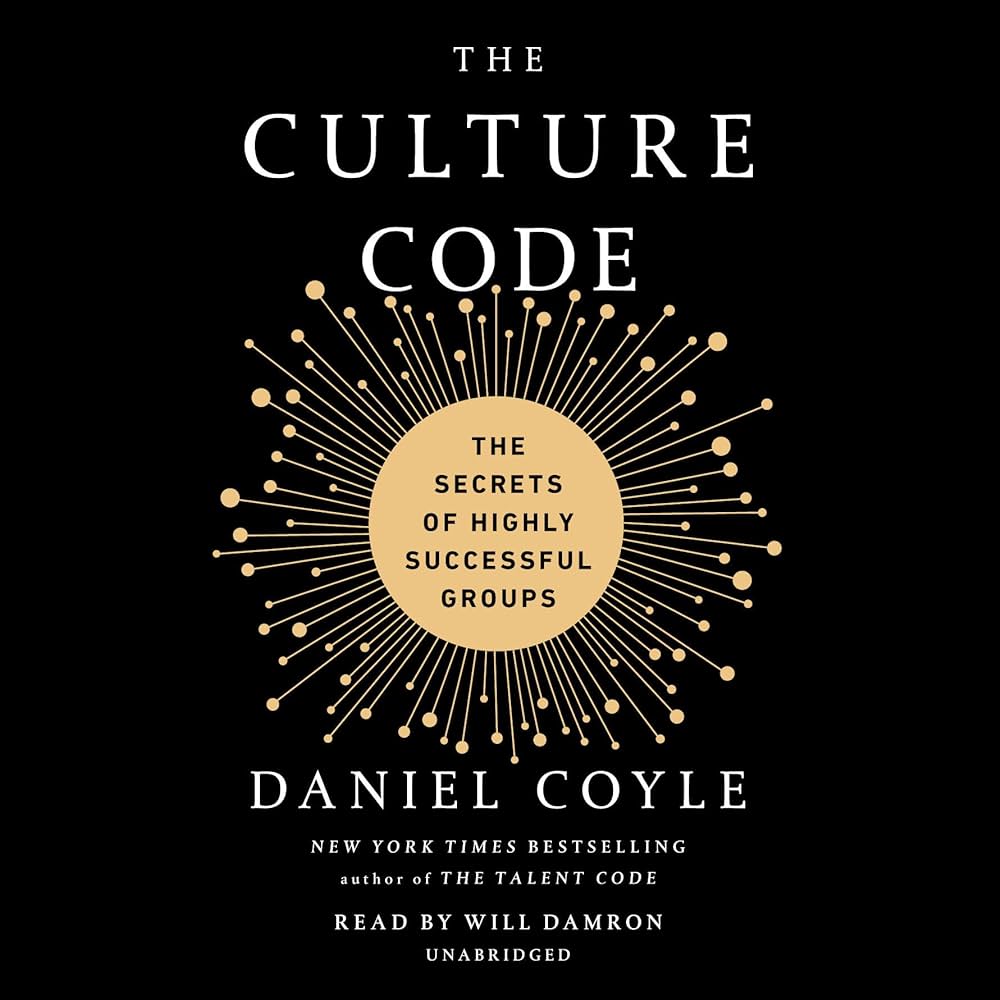
The Culture Code เขียนโดย Daniel Coyle เขาได้ทำการสำรวจองค์กรที่ประสบความสำเร็จแล้วก็พบว่า องค์กรเหล่านั้นมีปัจจัยที่ทำให้ประสบความสำเร็จหลายอย่างที่คล้ายคลึงกัน และนั่นจึงเป็นเหตุผลที่สำคัญที่ทำให้องค์กรเหล่านั้นสามารถเติบโตและก้าวหน้าต่อไปได้ อย่างต่อเนื่องและยั่งยืน
ในบทความนี้ จะเป็นการถอดบทเรียนที่ได้จาก The Culture Code ซึ่งพวกเราสามารถใช้เป็นแนวทางในการยกระดับงานและชีวิตส่วนตัวของเรา หรือ ส่งเสริมการเติบโต หรือการสื่อสารที่มีประสิทธิภาพ และเพิ่มความเข้าใจที่ลึกซึ้งมากยิ่งขึ้นเกี่ยวกับพฤติกรรมของมนุษย์
ความสำคัญของวัฒนธรรม
วัฒนธรรมไม่ได้เป็นเพียงฉากหลังเท่านั้น มันเป็นช่วงที่ชีวิตของเราที่เราต้องใช้ชีวิตอยู่ในสังคมหรือองค์กรในทุกๆ วัน
ในหนังสือเล่มนี้ ได้อธิบายเอาไว้ว่าวัฒนธรรมมีอิทธิพลอย่างลึกซึ้งต่อค่านิยม พฤติกรรม และความสัมพันธ์ของเราอย่างไร ไม่ใช่แค่การตระหนักถึงบรรทัดฐานทางวัฒนธรรมเท่านั้น แต่ยังเข้าใจว่าวัฒนธรรมหล่อหลอมความคิดและการตัดสินใจของเราอย่างไร?
ตัวอย่าง: ในหนังสือ Coyle ได้เล่าเรื่องราวของทีมเบสบอล San Francisco Giants และการพลิกฟื้นทีมที่น่าทึ่งของพวกเขา โดยจากการสร้างวัฒนธรรมของการอยู่ร่วมกันและการเป็นส่วนหนึ่งของทีม ด้วยการเปิดรับการเปลี่ยนแปลงทางวัฒนธรรม พวกเขาเปลี่ยนจากทีมรองบ่อนจนมาเป็นแชมป์ World Series ได้
การสร้างความไว้วางใจในทีม
ความไว้วางใจ คือสิ่งที่ยึดเหนี่ยวทีมที่มีประสิทธิภาพเข้าด้วยกัน
ข้อมูลเชิงลึกของ Coyle ให้ความกระจ่างเกี่ยวกับความสำคัญของความไว้วางใจในพลวัตของทีม ด้วยการส่งเสริมความไว้วางใจ เราสามารถปลูกฝังทีมที่สนับสนุนและเหนียวแน่นโดยที่สมาชิกต้องพึ่งพาจุดแข็งของกันและกัน
ตัวอย่าง: Coyle ได้เล่าเรื่องราวเกี่ยวกับหน่วยซีลกองทัพเรือสหรัฐฯ แสดงให้เห็นว่าความไว้วางใจและความสามัคคีของพวกเขาถูกสร้างขึ้นมาได้อย่างไร? ผ่านการฝึกอบรมที่เข้มข้นและการแบ่งปันประสบการณ์ ความไว้วางใจอันแน่วแน่ของพวกเขาที่มีต่อกัน ถือเป็นหัวใจสำคัญต่อความสำเร็จในภารกิจที่ท้าทาย
พลังของการเล่าเรื่องที่ใช้ร่วมกัน
เรื่องเล่ามีสามารถช่วยรวบรวมจิตใจของผู้คนเข้าด้วยกันได้
ข้อมูลการศึกษาของ Coyle ได้เน้นย้ำถึงศักยภาพของการเล่าเรื่องในการสร้างจุดประสงค์ร่วมกันและขับเคลื่อนการเปลี่ยนแปลง ด้วยการสร้างเรื่องราวที่น่าสนใจ เราสามารถดึงดูดใจและความคิดของผู้คนได้
ตัวอย่าง: การสำรวจวัฒนธรรมการเล่าเรื่องอันเป็นเอกลักษณ์ของพิกซาร์ ในหนังสือเล่มนี้ได้เผยให้เห็นว่าการเล่าเรื่องที่มีการแบ่งปัน เช่น ในการสร้าง “Toy Story” มีส่วนช่วยต่อยอดความสำเร็จและผลกระทบทางอารมณ์เชิงบวกของบริษัทอย่างไร เป็นต้น
บทบาทที่สำคัญของความอ่อนแอ
ในโลกที่มักมองว่าความอ่อนแอเป็นจุดอ่อน Coyle กลับพลิกเรื่องราวให้เห็นอีกด้าน เขาแสดงให้เห็นว่าการเปิดใจยอมรับความอ่อนแอของกันและกัน สามารถกระชับความสัมพันธ์ ส่งเสริมนวัตกรรม และส่งเสริมการเติบโตส่วนบุคคลได้อย่างไร
ตัวอย่าง: Coyle ได้เล่าให้ฟังถึงข้อมูลจากความเปราะบางหรือความอ่อนแอของหน่วยซีลกองทัพเรือสหรัฐฯ เขาแสดงให้เห็นว่าการยอมรับความกลัวและความอ่อนแอของคนในทีม ช่วยเสริมสร้างความผูกพันและช่วยให้ภารกิจของพวกเขาประสบความสำเร็จได้อย่างไร เป็นต้น
วงจรการเรียนรู้ทักษะ
การเรียนรู้ทักษะใหม่ๆ เปรียบเสมือน การเดินทางที่ไม่สิ้นสุด
Coyle ได้นำเสนอ วงจรการเรียนรู้ทักษะ ซึ่งเป็นกลไกที่แสดงให้เห็นว่าการฝึกฝนอย่างมีสมาธิ และข้อเสนอแนะรวมไปถึงวิธีการพัฒนา ปรับปรุงตนเองอย่างต่อเนื่อง สามารถช่วยเร่งการได้มาซึ่งทักษะได้อย่างไร
ตัวอย่าง: กรณีของนักฟุตบอลชาวบราซิล Ronaldinho หรือ ที่รู้จักกันในชื่อ “พ่อมดฟุตบอล” เน้นย้ำถึงวงจรการเรียนรู้ทักษะที่เกิดขึ้นจริง ผ่านการฝึกฝนอย่างไม่หยุดยั้งและการได้คำแนะนำจากที่ปรึกษาที่ดี ทำให้เขากลายเป็นผู้เล่นระดับตำนาน
วิธีการสร้างความเป็นเจ้าของ
การรู้สึกว่าเราเป็นส่วนหนึ่งของสังคม หรือ องค์กรที่เราอยู่เป็นความต้องการทางธรรมชาติของมนุษย์
Coyle แสดงให้เห็นว่าการไม่แบ่งแยก สามารถส่งเสริมความรู้สึกถึงการเป็นเจ้าของ และจุดประกายสร้างแรงจูงใจได้อย่างไร ด้วยการสร้างสภาพแวดล้อมที่ทุกคนรู้สึกมีคุณค่า เราสามารถส่งเสริมการเติบโตส่วนบุคคล และส่วนรวมได้
ตัวอย่าง: ในหนังสือเล่มนี้ ได้เล่าถึงเรื่องราวของเมืองโรเซโต รัฐเพนซิลวาเนีย เมืองที่ชุมชนที่นี่มีความสัมพันธ์ใกล้ชิดกัน ส่งเสริมความเป็นเจ้าของ ผู้อยู่อาศัยมีความสัมพันธ์กันอย่างแน่นแฟ้น ผู้อยู่อาศัยมีส่วนร่วมในกิจกรรมของชุมชน แบ่งปันระบบการสนับสนุนทางสังคมที่เข้มแข็ง และแสดงให้เห็นถึงความห่วงใยความเป็นอยู่ของกันและกันอย่างแท้จริง ความรู้สึกเป็นส่วนหนึ่งของเมืองนี้เอง เป็นสิ่งที่นำไปสู่ผลลัพธ์ด้านสุขภาพที่น่าทึ่ง
พลวัตของวัฒนธรรมที่มีสมรรถนะสูง
วัฒนธรรมที่มีประสิทธิภาพสูงไม่ได้เกิดขึ้นเอง แต่ต้องถูกสร้างขึ้น ข้อมูลเชิงลึกของ Coyle เปิดเผยให้เห็นองค์ประกอบที่จำเป็นในการสร้างสภาพแวดล้อมที่สนับสนุนความเป็นเลิศขององค์กร
ตัวอย่าง: Coyle ได้วิเคราะห์วัฒนธรรมของซานอันโตนิโอ สเปอร์ส ซึ่งเป็นทีมบาสเกตบอลมืออาชีพที่ประสบความสำเร็จอย่างต่อเนื่องมาอย่างยาวนาน และปัจจัยที่ทำให้ซานอันโตนิโอ สเปอร์ส ประสบความสำเร็จ มาจากวัฒนธรรมที่มีประสิทธิภาพสูงซึ่งสร้างขึ้นมาจากการมีวินัยและค่านิยมที่ทีมงานทุกคนมีร่วมกันนั่นเอง
ศิลปะแห่งการรับมือกับคำติชม
ข้อเสนอแนะที่สร้างสรรค์ ถือเป็นของขวัญ
Coyle ได้เน้นย้ำให้เห็นถึงพลังในการเปลี่ยนแปลงที่มาจากคำติชม ในหนังสือเล่มนี้ นำเสนอกลยุทธ์ในการให้และรับข้อเสนอแนะ หรือ คำติชม อย่างมีประสิทธิภาพ ซึ่งจะช่วยส่งเสริมการเติบโตส่วนบุคคลและทางอาชีพได้
ตัวอย่าง: Coyle ได้เล่าให้ฟังถึงกรณีศึกษาของบริษัทออกแบบอย่าง IDEO ที่แสดงให้เห็นว่าการออกความคิดเห็นเชิงสร้างสรรค์ นำไปสู่การออกแบบผลิตภัณฑ์ที่ก้าวล้ำ และเป็นที่ต้องการของลูกค้าได้อย่างไร
จุดประกายการเปลี่ยนแปลง
การเปลี่ยนแปลงมักจะมาพร้อมกับการต่อต้าน
Coyle ได้แนะนำผู้อ่านเกี่ยวกับวิธีการจุดประกายการเปลี่ยนแปลงให้ประสบความสำเร็จภายในองค์กร โดยใช้ประโยชน์จากการเปลี่ยนแปลงทั้งปัจจัยขนาดเล็กและขนาดใหญ่ควบคู่กัน
ตัวอย่าง: Coyle ได้แบ่งปันเรื่องราวของ Martin Davidson ผู้เป็นหัวหอกในการเปลี่ยนแปลงวัฒนธรรมที่ Darden School of Business ในรัฐเวอร์จิเนีย ด้วยการเปลี่ยนแปลงเชิงกลยุทธ์ เขาได้เปลี่ยนโรงเรียนให้เป็นสถาบันที่มีความหลากหลายและครอบคลุมหลายด้านมากขึ้น
พลังแห่งสัญญาณ
ภาพและสัญลักษณ์ถือเป็นเครื่องมืออันทรงพลัง
Coyle ได้อธิบายว่าสัญญาณในสภาพแวดล้อมของเรา มีอิทธิพลต่อพฤติกรรมและการตัดสินใจอย่างไร
ตัวอย่าง: การวิเคราะห์เกี่ยวกับความเอาใจใส่อย่างพิถีพิถันของนาวิกโยธินสหรัฐฯ ต่อมาตรฐานและศุลกากรที่สม่ำเสมอ เน้นถึงผลกระทบของสัญญาณที่มีต่อวินัยและการทำงานร่วมกัน
อิทธิพลของสถานที่
สภาพแวดล้อมทางกายภาพของเราส่งผลต่อพฤติกรรมของเรา
Coyle ได้นำเสนอข้อมูลเชิงลึกในการปรับพื้นที่ทำงานของเราให้เหมาะสม เพื่อเพิ่มประสิทธิภาพการทำงานและความคิดสร้างสรรค์
ตัวอย่าง: Coyle ได้มีโอกาสตรวจสอบการออกแบบพื้นที่ทำงานของบริษัท IDEO ซึ่งเขาพบว่า รูปแบบการทำงานของที่นี่เป็นที่ที่เปิดกว้าง ส่งเสริมการทำงานร่วมกันและการสร้างนวัตกรรม
ความลับในการเปลี่ยนแปลงวัฒนธรรม
การเปลี่ยนแปลงทางวัฒนธรรมเป็นความพยายามที่ทะเยอทะยานและท้าทาย
แต่สิ่งสำคัญก็คือการเปลี่ยนแปลงเชิงบวกจะสร้างความยั่งยืนในชีวิตส่วนตัวและอาชีพของเราได้
ตัวอย่าง: การสำรวจการเปลี่ยนแปลงในเรือนจำอัลคาทราซ แสดงให้เห็นว่าการเปลี่ยนแปลงทางวัฒนธรรมเชิงบวกสามารถฟื้นฟูจิตใจของคน ถึงแม้ว่าจะอยู่ในสภาพแวดล้อมที่ท้าทายที่สุดได้อย่างไร
ความเป็นผู้นำในการสร้างวัฒนธรรม
ผู้นำมีบทบาทสำคัญเป็นอย่างยิ่งในการสร้างวัฒนธรรม
หนังสือเล่มนี้เน้นย้ำถึงความสำคัญของความเป็นผู้นำที่มีประสิทธิภาพในการสร้างวัฒนธรรมที่มีชีวิตชีวาและขับเคลื่อนองค์กร คน ด้วยวัตถุประสงค์
ตัวอย่าง: หนังสือเล่มนี้เจาะลึกความเป็นผู้นำของ Gregg Popovich โค้ชของทีม San Antonio Spurs ซึ่งมีรูปแบบความเป็นผู้นำที่ปลูกฝังความรู้สึกที่ทุกคนต้องถึงจุดมุ่งหมายร่วมกันระหว่างสมาชิกในทีม เป็นต้น
ศาสตร์แห่งการเชื่อมต่อความสัมพันธ์
การเชื่อมต่อความสัมพันธ์ถือเป็นความต้องการขั้นพื้นฐานของมนุษย์ Coyle ได้เจาะลึกวิทยาศาสตร์ที่อยู่เบื้องหลังการสร้างความสัมพันธ์และการรักษาความสัมพันธ์ โดยทั้งสองเรื่องมีผลในการเสริมสร้างความเข้มแข็งให้กับคนในสังคมหรือองค์กร
ตัวอย่าง: การวิเคราะห์ของ Coyle เกี่ยวกับชุมชน Roseto ซึ่งเป็นชาวอิตาเลียนอเมริกันที่มีความสัมพันธ์ใกล้ชิดกัน เน้นย้ำถึงผลกระทบอย่างลึกซึ้งของความสัมพันธ์ทางสังคมที่เข้มแข็งต่อสุขภาพและความเป็นอยู่ที่ดี เป็นต้น
พิธีกรรมที่สำคัญ
พิธีกรรมให้ความรู้สึกต่อเนื่องและเป็นส่วนหนึ่งของสังคมและองค์กร
Coyle พบว่าพิธีกรรมต่างๆ ที่เกิดขึ้นในสังคม หรือ องค์กร ล้วนมีความหมายในชีวิตกับคนในสังคมหรือในองค์กรนั้น ไม่ว่าจะเป็นในครอบครัว ที่ทำงาน หรือในชุมชน
ตัวอย่าง: หนังสือเล่มนี้เจาะลึกพิธีกรรมอันทรงพลังของหน่วยซีลกองทัพเรือสหรัฐฯ ซึ่งแสดงให้เห็นว่าพิธีกรรมเหล่านี้สร้างความผูกพันที่อยู่เหนือสนามรบได้อย่างไร
ศิลปะแห่งการฟัง
การฟังเป็นศิลปะอย่างนึงที่สำคัญของมนุษย์
การพัฒนาทักษะการฟังของเรา จะสามารถเสริมสร้างความสัมพันธ์ การสื่อสาร และการแก้ปัญหาได้
ตัวอย่าง: Coyle ได้ทำการสำรวจแนวทางปฏิบัติในการฟังอย่างลึกซึ้งของนักดนตรีระดับตำนานอย่าง Bob Dylan ซึ่งแสดงให้เห็นว่าการฟังอย่างกระตือรือร้นช่วยเพิ่มประสิทธิภาพการแต่งเพลงของเขาได้อย่างไร
พลังแห่งการสรรเสริญ
การสรรเสริญเป็นแรงกระตุ้นที่ทรงพลัง หนังสือเล่มนี้อธิบายถึงศิลปะแห่งการสรรเสริญอย่างจริงใจ และมีประสิทธิภาพ ซึ่งเป็นเครื่องมือที่สามารถสร้างแรงบันดาลใจและให้กำลังใจผู้อื่นได้
ตัวอย่าง: ตัวอย่างเกี่ยวกับการยกย่องและการยอมรับภายในนาวิกโยธินสหรัฐฯ เป็นตัวอย่างว่าแนวปฏิบัตินี้กระตุ้นให้นาวิกโยธินมีความเป็นเลิศอย่างไร
การยอมรับความหลากหลาย
ความหลากหลายไม่ใช่แค่คำศัพท์เท่านั้น มันเป็นแหล่งรวมของความเข้มแข็ง
ข้อดีของการเปิดรับมุมมองที่หลากหลาย ซึ่งสามารถนำไปสู่นวัตกรรมใหม่ๆ และยังรวมไปถึงความสามารถในการปรับตัวได้
ตัวอย่าง: หนังสือเล่มนี้นำเสนอความร่วมมือระดับโลกของบริษัทออกแบบ IDEO ที่ซึ่งมีแนวความคิดที่หลากหลายนำไปสู่โซลูชั่นที่เป็นนวัตกรรมที่มีความน่าสนใจและเป็นที่ต้องการของลูกค้าเป็นต้น
บทบาทของการทำซ้ำ
การทำซ้ำเป็นเครื่องมืออันทรงพลังสำหรับการเรียนรู้
Coyle ได้เน้นย้ำถึงความสำคัญของการทำซ้ำและการฝึกฝนโดยเจตนาในการเรียนรู้ทักษะและการได้มาซึ่งความเชี่ยวชาญ
ตัวอย่าง: หนังสือเล่มนี้เจาะลึกการฝึกฝนอย่างมีระเบียบวินัยของนักฟุตบอลชาวบราซิล ที่ฝึกฝนการเคลื่อนไหวแบบเดียวกันซ้ำแล้วซ้ำเล่า จนสามารถแสดงผลงานในสนามแข่งได้อย่างสมบูรณ์แบบ
ผลกระทบของวัตถุประสงค์
วัตถุประสงค์ที่ดีจะให้แรงจูงใจและทิศทางที่ถูกต้อง
Coyle เปิดเผยให้เห็นถึงความสำคัญของการมีเป้าหมายที่ชัดเจน ซึ่งสามารถกระตุ้นการเติบโตทั้งส่วนตัวและทางอาชีพได้
ตัวอย่าง: คอยล์สำรวจวัฒนธรรมที่ขับเคลื่อนด้วยวัตถุประสงค์ของทีมซานอันโตนิโอ สเปอร์ส ซึ่งเป้าหมายร่วมกันในการคว้าแชมป์ทำให้ทีมเป็นหนึ่งเดียวกัน
จากหนังสือ “The Culture Code”

รายละเอียดเพิ่มเติม : https://www.amazon.com/Culture-Code-Secrets-Highly-Successful/dp/0525492461
บทความแนะนำ
Eat That Frog: กินกบตัวนั้นซะ เคล็ดลับในการบริหารเวลาให้มีประสิทธิภาพดีที่สุด







